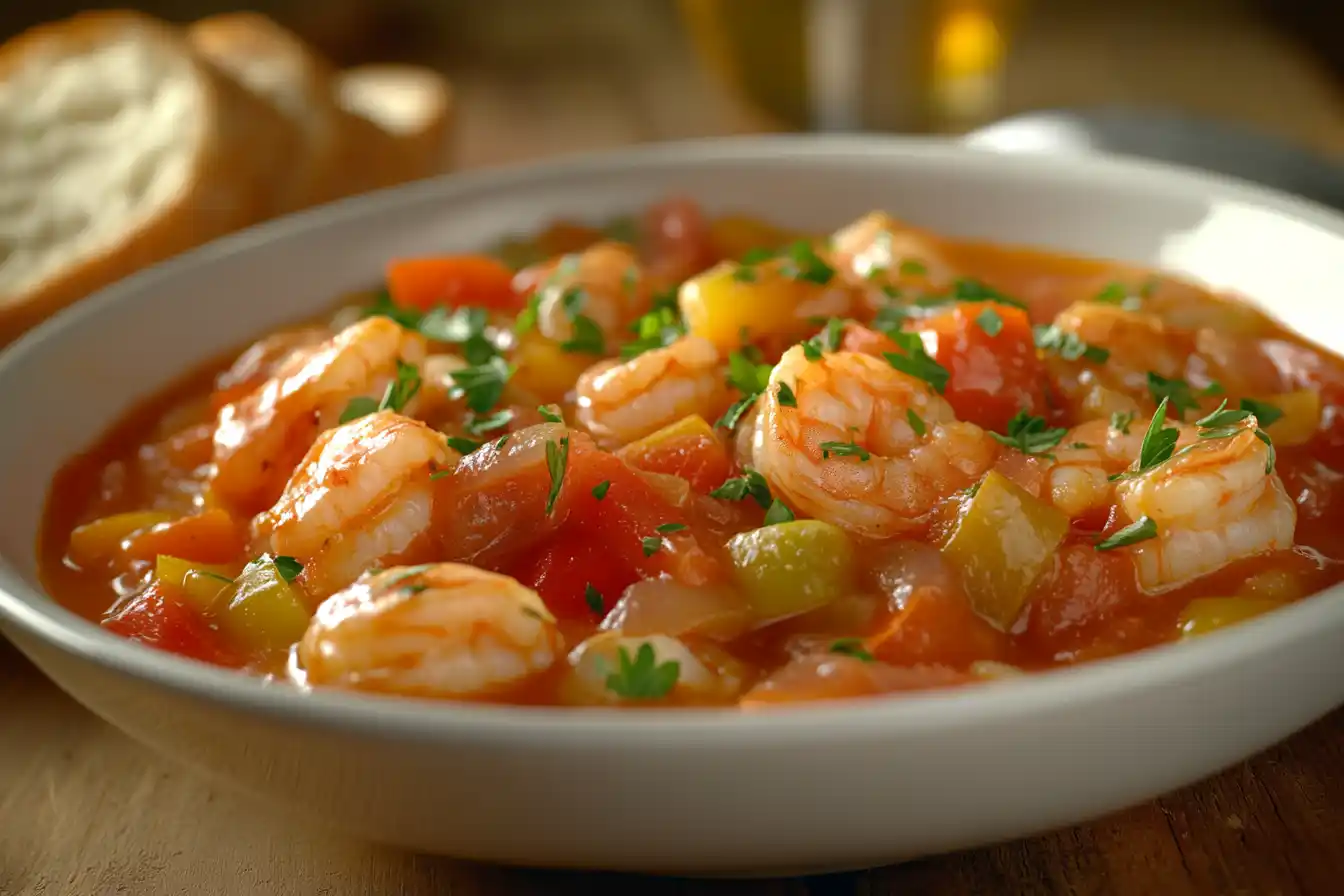Few dishes bring comfort quite like a steaming bowl of shrimp stew. Whether it’s the rich, slow-simmered Cajun version or the coconut-infused Brazilian take, this seafood dish has earned its place in kitchens worldwide. But what makes a perfect shrimp stew? How do you keep shrimp tender while maximizing flavor? And what are the best ingredients to use?
In this comprehensive guide, we’ll explore everything you need to know about shrimp stew—from its origins and essential ingredients to step-by-step cooking instructions and regional variations. Whether you’re a seasoned home cook or just getting started, this article will help you master the art of making this delicious seafood dish.
Table of Contents
Everything You Need to Know About Shrimp Stew
What is Shrimp Stew?
At its core, shrimp stew is a flavorful, slow-cooked dish featuring succulent shrimp, vegetables, and a rich, seasoned broth. Found in many cultures, it’s often served over rice or with crusty bread to soak up every last drop of goodness. Some versions rely on a dark, nutty roux, while others use tomatoes or coconut milk for a lighter touch.
Historical Background of Shrimp Stew
Shrimp has long been a staple in coastal communities, from the Louisiana bayous to the shores of Brazil and West Africa. Early recipes for seafood stews date back centuries, often evolving based on regional ingredients. The Creole and Cajun versions of shrimp stew, popular in the Southern United States, blend French, Spanish, and African influences, incorporating bold spices and hearty textures. Meanwhile, moqueca, a Brazilian shrimp stew, showcases coconut milk and palm oil, reflecting the country’s Portuguese and African heritage.
Cultural Significance of Shrimp Stew in Various Cuisines
Shrimp stew is more than just a dish—it’s a symbol of hospitality and tradition. In Louisiana, it’s a staple of family gatherings and Mardi Gras feasts. In West Africa, seafood stews are commonly served at celebrations, reflecting the abundance of fresh seafood in coastal regions. No matter where it’s made, shrimp stew brings people together, offering warmth and comfort in every bite.
Essential Ingredients for a Flavorful Shrimp Stew
Crafting a delectable shrimp stew hinges on selecting the right ingredients. Each component plays a pivotal role in building depth and richness, resulting in a dish that’s both comforting and flavorful.
Selecting the Best Shrimp for Your Stew
Choosing fresh, high-quality shrimp is paramount. Opt for shrimp that are firm to the touch and have a mild, sea-like aroma. Both fresh and frozen shrimp can be used; if using frozen, ensure they’re properly thawed before cooking. or a detailed guide on preparing shrimp in a slow cooker, you might find this resource helpful.
The Holy Trinity: Onions, Bell Peppers, and Celery
In many shrimp stew recipes, especially those with Cajun or Creole roots, the “Holy Trinity” of onions, bell peppers, and celery forms the flavor base. Sautéing these vegetables releases their natural sweetness and creates a savory foundation for the stew.
Broth and Seasonings: Building the Perfect Base
A rich, flavorful broth is essential. Seafood or chicken broth works well, providing depth without overpowering the shrimp. Seasonings like garlic, thyme, bay leaves, and a touch of cayenne pepper can enhance the stew’s complexity. or a spicy twist, consider incorporating elements from these spicy shrimp recipes.
Optional Additions: Sausage, Okra, and Other Enhancements
To elevate your shrimp stew, consider adding ingredients like smoked sausage for a smoky depth, or okra, which can act as a natural thickener. Tomatoes can introduce acidity and balance, while herbs like parsley or cilantro add freshness. xploring various stew recipes can offer inspiration for unique additions.
Step-by-Step Guide to Preparing Classic Shrimp Stew
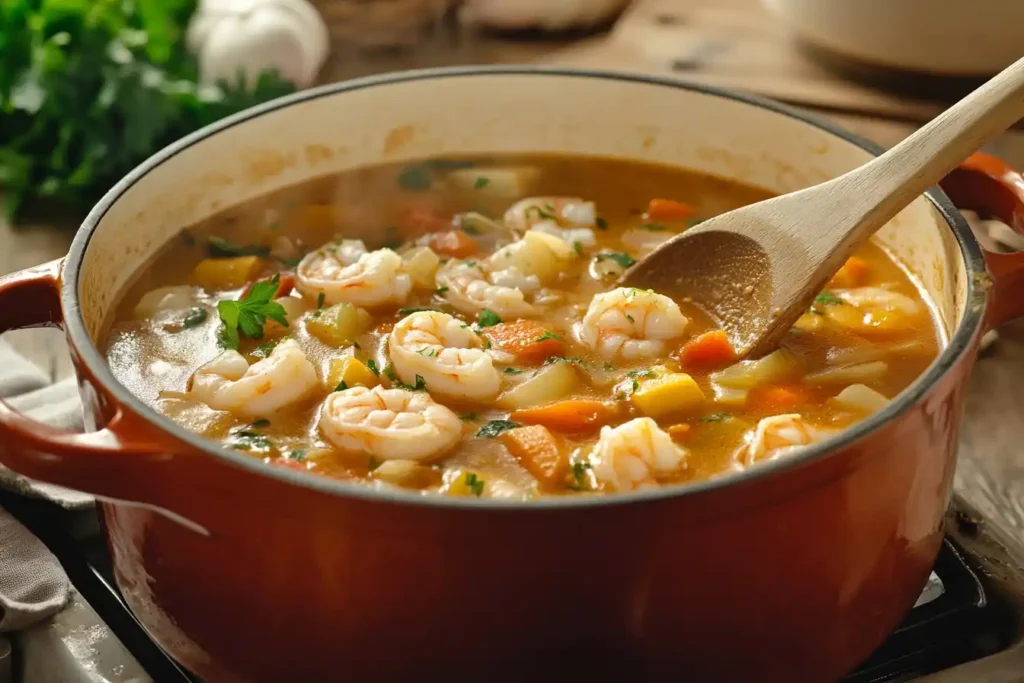
Creating a classic shrimp stew involves a series of deliberate steps, each contributing to the dish’s overall flavor and texture. Here’s a comprehensive guide to crafting this comforting meal.
Preparing the Shrimp: Cleaning and Deveining
Start by peeling and deveining the shrimp. Removing the shells and veins ensures a clean taste and pleasant texture. Rinse the shrimp under cold water and pat them dry with paper towels.
Crafting the Roux: The Foundation of Flavor
A roux—a mixture of fat and flour cooked together—serves as the thickening agent and flavor base for many stews. In a heavy-bottomed pot, melt butter over medium heat. Gradually whisk in flour, stirring continuously to prevent lumps. Cook until the roux reaches a light brown color, imparting a nutty aroma.
Sautéing the Vegetables: Extracting Maximum Taste
Add the diced onions, bell peppers, and celery to the roux. Sauté until the vegetables soften and release their flavors, approximately 5-7 minutes. This step builds the aromatic foundation of the stew.
Simmering the Stew: Combining Ingredients for Optimal Flavor
Pour in the broth, stirring to combine with the roux and vegetables. Bring the mixture to a gentle boil, then reduce the heat to a simmer. Add seasonings such as garlic, thyme, bay leaves, and cayenne pepper. Let the stew simmer for about 20 minutes, allowing the flavors to meld.
Final Touches: Adjusting Seasonings and Consistency
Add the prepared shrimp to the pot, stirring gently. Cook until the shrimp turn pink and opaque, typically 3-5 minutes. Taste the stew and adjust the seasonings as needed, adding salt, pepper, or additional spices to suit your preference. If the stew is too thick, incorporate a bit more broth; if too thin, let it simmer a bit longer to reduce.
By following these steps, you’ll create a shrimp stew that’s rich, flavorful, and satisfying—a true testament to the art of slow-cooked comfort food.
Regional Variations of Shrimp Stew
Shrimp stew boasts a rich tapestry of regional variations, each reflecting local ingredients and cultural influences. From the spicy depths of Cajun country to the tropical flavors of Brazil, let’s explore some notable renditions of this beloved dish.
Cajun Shrimp Stew: A Spicy Southern Delight
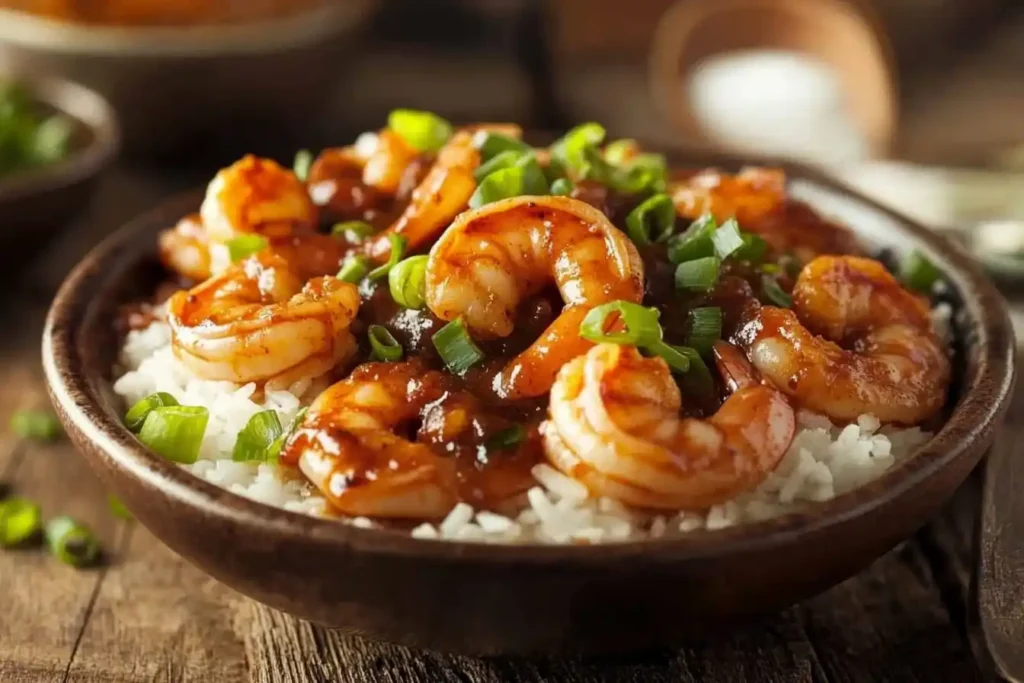
In the heart of Louisiana, Cajun shrimp stew is a staple that embodies the region’s zest for bold flavors. This version typically starts with a dark roux, achieved by patiently cooking flour and oil until it reaches a deep brown hue. The “Holy Trinity” of onions, bell peppers, and celery is then sautéed, followed by the addition of garlic and tomatoes. Seasoned with Cajun spices, the stew simmers to meld the flavors before introducing the shrimp, which cook just until tender. The result is a hearty, spicy dish often served over rice.
Creole Shrimp Stew: A Tomato-Based Twist
Creole cuisine offers a tomato-rich variation of shrimp stew. This version also begins with the “Holy Trinity,” but incorporates tomatoes and tomato paste to create a vibrant, tangy base. Herbs like thyme and bay leaves, along with Creole seasoning, infuse the stew with aromatic depth. Shrimp are added towards the end, ensuring they remain tender. Often, this stew is accompanied by okra, which not only enhances flavor but also acts as a natural thickener. Served over rice, Creole shrimp stew offers a harmonious blend of savory and tangy notes.
Brazilian Moqueca: A Coconut-Infused Seafood Stew
Traveling south to Brazil, we encounter moqueca, a delightful seafood stew that showcases the country’s tropical flavors. This dish features shrimp simmered in a fragrant mixture of coconut milk, tomatoes, onions, bell peppers, and cilantro. A distinctive element is the use of dendê (palm oil), which imparts a unique, rich flavor. The stew is typically cooked in a clay pot, enhancing its earthy undertones. Served with rice and farofa (toasted cassava flour), moqueca offers a creamy, aromatic experience that transports diners to Brazil’s coastal regions.
West African Shrimp Stew: Rich Flavors from the Motherland
West African cuisine presents a hearty shrimp stew that reflects the region’s love for bold, earthy flavors. This version often includes ingredients like tomatoes, onions, garlic, and ginger, creating a robust base. Peanut butter or ground peanuts are sometimes incorporated, adding depth and a subtle nuttiness. Spices such as paprika, cayenne, and curry powder lend warmth and complexity. The shrimp are simmered until tender, absorbing the rich flavors of the stew. Typically served with rice or fufu, this stew offers a comforting and satisfying meal.
These regional variations highlight the versatility of shrimp stew, each bringing its own unique blend of flavors and traditions to the table.
Tips and Tricks for the Perfect Shrimp Stew
Crafting the ideal shrimp stew involves attention to detail and a few insider tips to elevate your dish from good to exceptional.
Avoiding Overcooked Shrimp: Timing is Key
Shrimp cook rapidly, and overcooking can lead to a rubbery texture. To prevent this, add shrimp towards the end of the cooking process. Once they turn pink and opaque, usually within 3-5 minutes, promptly remove the pot from heat. This ensures the shrimp remain tender and succulent.
Enhancing Flavor with Homemade Seafood Stock
A rich, flavorful base is crucial for a standout shrimp stew. Instead of relying solely on store-bought broth, consider making a homemade seafood stock. Sauté shrimp shells with aromatics like onions, celery, and carrots, then simmer with water for about 30 minutes. Strain the liquid, and you’ll have a robust stock that deepens the stew’s flavor profile.
Thickening Your Stew: Roux, Okra, and Filé Powder
Achieving the desired consistency in your shrimp stew can be accomplished through various methods:
- Roux: A mixture of fat and flour cooked together, roux not only thickens the stew but also adds a nutty depth.
- Okra: Common in Creole versions, okra releases a natural thickening agent when cooked, contributing both texture and flavor.
- Filé Powder: Made from ground sassafras leaves, filé powder is traditionally used in gumbo to thicken and flavor the stew.
Choose the thickening agent that best complements your desired flavor and texture.
Serving Suggestions: Pairing Shrimp Stew with Sides
To complete your meal, consider these accompaniments:
- Rice: A classic pairing, rice absorbs the flavorful broth, making each bite satisfying.
- Crusty Bread: Ideal for sopping up the savory stew, a good loaf adds a delightful crunch.
- Potato Salad: In some regions, a side of creamy potato salad complements the stew’s spices and offers a cooling contrast.
By following these tips and tricks, you’ll be well on your way to creating a shrimp stew that’s rich, flavorful, and sure to impress.
For more delicious recipes, check out our Slow Cooker Shrimp Recipes.
Common Mistakes to Avoid When Making Shrimp Stew
Even the best cooks can run into trouble when preparing shrimp stew. From overcooked shrimp to a bland broth, small missteps can impact the final dish. Here are some common mistakes to avoid.
Overcooking the Shrimp
Shrimp are delicate and cook in minutes. If left in the pot too long, they turn rubbery and lose their juicy texture. To avoid this, add shrimp towards the end of the cooking process. Once they turn pink and opaque, they’re done! Removing the pot from heat and letting the stew sit for a few minutes ensures the shrimp remain tender.
Skipping the Roux or Base
The foundation of a great shrimp stew is its base. Skipping the roux (flour and fat mixture) or not letting it cook long enough results in a thin, flavorless stew. A well-made roux adds richness and depth. If using a tomato-based version, sautéing the tomatoes and spices properly enhances their flavors.
Using Low-Quality Shrimp
Fresh shrimp always yield the best results. Avoid pre-cooked shrimp—they don’t absorb flavor well and can turn rubbery. If using frozen shrimp, thaw them completely and pat them dry before adding them to the stew.
Not Seasoning Properly
A bland shrimp stew is disappointing. Proper seasoning—like salt, black pepper, garlic, thyme, and a pinch of cayenne—creates a well-balanced dish. Always taste and adjust the seasoning before serving.
Storing and Reheating Shrimp Stew
If you have leftovers, storing and reheating shrimp stew properly ensures it stays delicious. Follow these steps to keep your stew fresh.
Proper Storage Tips
For best results, store shrimp stew in an airtight container in the refrigerator. Since shrimp spoil quickly, consume within 2 to 3 days. If you need to keep it longer, freezing is an option. Freeze in portioned containers to make reheating easier.
How to Reheat Without Overcooking
Shrimp are delicate, so reheating requires care. Avoid the microwave—it can make shrimp rubbery. Instead:
- Stovetop Method (Best Option): Pour the stew into a saucepan and reheat over low heat. Stir occasionally and heat just until warm.
- Water Bath Method: Place a heatproof container of stew in a warm water bath to gently bring it to temperature.
- Oven Method: If reheating a large batch, place the stew in an oven-safe dish, cover it with foil, and heat at 275°F (135°C) for about 15 minutes.
Can You Freeze Shrimp Stew?
Yes, but with some caution. The broth freezes well, but shrimp can become rubbery after thawing. To prevent this, remove shrimp before freezing and add fresh shrimp when reheating. Use frozen stew within 2 months for best taste.
By following these tips, your shrimp stew will taste just as good the next day!
Nutritional Information for Shrimp Stew
Eating shrimp stew is not just about flavor—it also provides essential nutrients. Shrimp is a great source of lean protein, vitamins, and minerals, while the broth and vegetables contribute fiber and antioxidants. Below is the approximate nutritional content per 100g serving of shrimp stew.
Nutritional Content (Per 100g)
| Nutrient | Amount |
|---|---|
| Calories | 80 kcal |
| Protein | 10g |
| Carbohydrates | 6g |
| Fats | 2.5g |
| Saturated Fat | 0.5g |
| Fiber | 1g |
| Sodium | 450mg |
| Cholesterol | 85mg |
| Vitamin A | 8% DV |
| Vitamin C | 10% DV |
| Calcium | 4% DV |
| Iron | 6% DV |
Health Benefits of Shrimp Stew
- High in Protein: Shrimp provides lean protein, helping with muscle repair and growth.
- Low in Calories: A light yet filling dish, perfect for balanced eating.
- Rich in Vitamins: Packed with Vitamin A, C, and essential minerals for immune and bone health.
- Omega-3 Benefits: Shrimp contains omega-3 fatty acids, known for promoting heart health.
Enjoy shrimp stew as part of a nutritious, well-balanced diet!
Frequently Asked Questions (FAQs) about Shrimp Stew
When making shrimp stew, many home cooks have questions about technique, ingredients, and troubleshooting. Here are answers to some of the most common queries.
Can You Overcook Shrimp in Stew?
Yes! Overcooked shrimp become tough and rubbery, losing their delicate texture. To avoid this, always add shrimp towards the end of the cooking process. Once they turn pink and opaque—usually within 3 to 5 minutes—remove the pot from heat. Let the residual warmth finish the cooking, ensuring tender, juicy shrimp
Why Do You Put Baking Soda in Shrimp?
Some recipes recommend tossing shrimp with a baking soda and salt mixture before cooking. This technique enhances the shrimp’s natural firmness and juiciness. The baking soda alters the protein structure, helping the shrimp retain moisture during cooking. Just rinse well before adding them to your stew to avoid any lingering taste.
How Does Paula Deen Boil Shrimp?
Paula Deen’s method for boiling shrimp involves seasoned water with lemon, bay leaves, and plenty of Old Bay seasoning. She brings the water to a rolling boil, adds the shrimp, and cooks them quickly—usually 2 to 3 minutes—until pink. While this method is for boiling, similar principles apply when adding shrimp to a stew: cook just long enough to keep them plump and tender.
How Do You Thicken Shrimp Stew?
If your shrimp stew is too thin, you have a few options for thickening:
Roux: A butter and flour mixture cooked to a golden brown before adding broth.
Cornstarch Slurry: A quick fix—mix cornstarch with a little water and stir it in.
Okra or Filé Powder: Traditional in Creole cuisine, these ingredients add both thickness and unique flavor.
Each method provides a different texture, so choose based on personal preference and regional style.
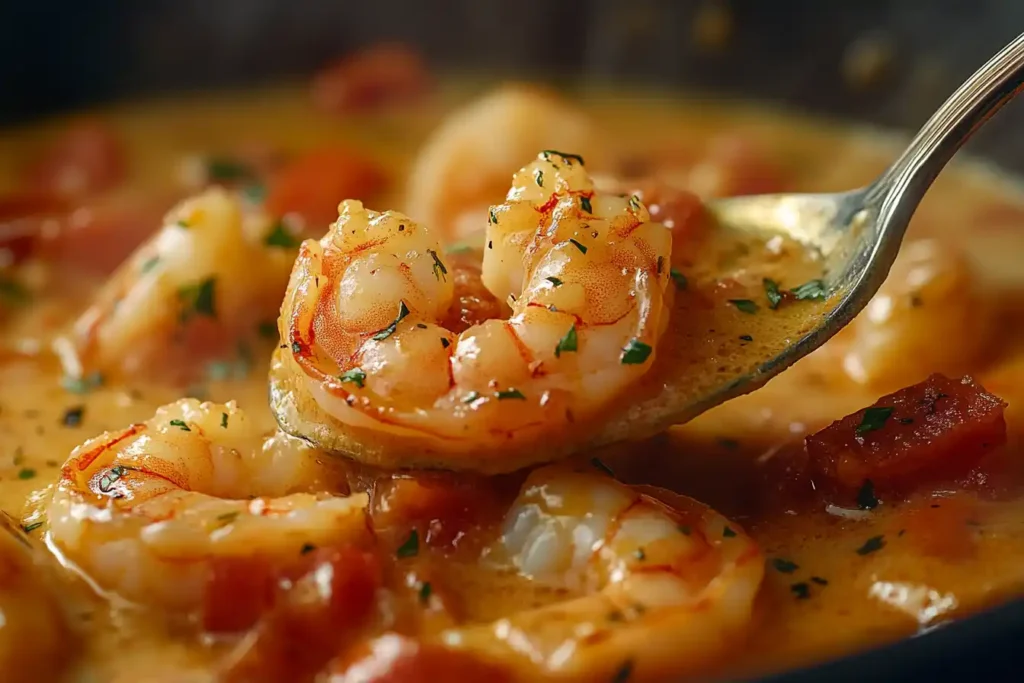
If your shrimp stew is too thin, you have a few options for thickening:
- Roux: A butter and flour mixture cooked to a golden brown before adding broth.
- Cornstarch Slurry: A quick fix—mix cornstarch with a little water and stir it in.
- Okra or Filé Powder: Traditional in Creole cuisine, these ingredients add both thickness and unique flavor.
Each method provides a different texture, so choose based on personal preference and regional style.
Final Tips for the Perfect Shrimp Stew
Few meals are as comforting and satisfying as a bowl of shrimp stew. Whether you prefer the spicy Cajun version, the tomato-based Creole take, or the coconut-infused Brazilian moqueca, this dish has something for everyone. It’s a meal steeped in tradition, yet adaptable to modern tastes.
The key to perfect shrimp stew lies in using quality ingredients and following proper cooking techniques. Selecting fresh shrimp, building a flavorful broth, and thickening the stew correctly can elevate an ordinary dish into a culinary masterpiece. And let’s not forget the importance of timing—shrimp cook quickly, and overcooking can ruin their texture.
Beyond its taste, shrimp stew is a dish that brings people together. Whether served over rice, with crusty bread, or alongside traditional Southern sides, it’s a meal that embodies warmth, comfort, and culture.
Now that you’ve mastered the art of making shrimp stew, why not explore more slow cooker seafood recipes to add to your repertoire? Experiment with flavors, try regional twists, and most importantly, enjoy every bite!
Print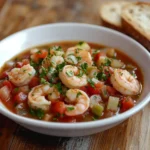
Shrimp Stew Recipe You’ll Want To Make Again & Again!
- Total Time: 55 minutes
- Yield: 4 1x
- Diet: Gluten Free
Description
This shrimp stew is a hearty, flavorful dish packed with tender shrimp, aromatic vegetables, and a thick, seasoned broth. Perfect for any occasion, this dish brings warmth and comfort in every bite.
Ingredients
- 1 lb shrimp, peeled and deveined
- 2 tbsp butter or oil
- 1 small onion, diced
- 1 bell pepper, diced
- 2 celery stalks, chopped
- 2 cloves garlic, minced
- 1 can (14 oz) diced tomatoes
- 4 cups seafood or chicken broth
- 1 tsp thyme
- 1 tsp smoked paprika
- ½ tsp cayenne pepper (optional)
- 1 bay leaf
- 2 tbsp flour (for thickening)
- 2 tbsp water (for slurry)
- Salt and black pepper, to taste
- Fresh parsley, for garnish
Instructions
- Prepare the shrimp – Clean and devein, then set aside.
- Sauté the vegetables – In a large pot, melt butter over medium heat. Add onion, bell pepper, celery, and garlic. Cook until soft.
- Add seasonings and broth – Stir in thyme, paprika, cayenne (if using), and bay leaf. Add diced tomatoes and broth, then bring to a simmer.
- Thicken the stew – Mix flour with water to form a slurry. Stir it into the stew and simmer for 20 minutes.
- Cook the shrimp – Add shrimp and cook for 3-5 minutes until pink and opaque.
- Adjust seasoning – Taste and add salt or pepper as needed. Remove bay leaf.
- Serve hot – Garnish with fresh parsley and serve over rice or with crusty bread.
Notes
- For a spicier kick, add extra cayenne or hot sauce.
- If the stew is too thick, add more broth to adjust consistency.
- Avoid overcooking shrimp to keep them tender.
- Prep Time: 15 minutes
- Cook Time: 40 minutes
- Category: Lunch
- Method: Stovetop
- Cuisine: Cajun, Creole
Nutrition
- Serving Size: 1 bowl (approx. 250g)
- Calories: 320 kcal
- Sugar: 4g
- Sodium: 450mg
- Fat: 12g
- Saturated Fat: 3g
- Unsaturated Fat: 7g
- Trans Fat: 0g
- Carbohydrates: 18g
- Fiber: 2g
- Protein: 22g
- Cholesterol: 85mg
